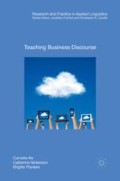Abstract
This chapter will:
-
Identify different types of learners and how to evaluate their needs;
-
Discuss how to define a set of learning outcomes and how to assess them;
-
Show how to move from the workplace to the classroom using a research-based approach aimed at understanding more about a set of learners and how they engage with business discourse;
-
Provide a case study that illustrates how to approach specialized professional discourse, together with a set of tasks related to learners and learning outcomes, and a set of further readings.
Access this chapter
Tax calculation will be finalised at checkout
Purchases are for personal use only
References
Charles, M., & Marschan-Piekkari, R. (2002). Language training for enhanced horizontal communication: A challenge for MNCs. Business Communication Quarterly, 65(2), 9–29.
Cheng, W., & Mok, E. (2008). Discourse processes and products: Land surveyors in Hong Kong. English for Specific Purposes, 27(1), 57–73.
Chew, S. K. (2005). An investigation of the English language skills used by new entrants in banks in Hong Kong. English for Specific Purposes, 24(4), 423–435.
Dafouz, E., & Mar Camacho-Miñano, M. (2016). Exploring the impact of English-medium instruction on university student academic achievement: The case of accounting. English for Specific Purposes, 44, 57–67.
Flowerdew, J., & Wan, A. (2010). The linguistic and the contextual in applied genre analysis: The case of the company audit report. English for Specific Purposes, 29(2), 78–93.
Fraser, L., Harich, K., Norby, J., Brzovic, K., Rizkallah, T., & Loewy, D. (2005). Diagnostic and value-added assessment of writing. Business Communication Quarterly, 68(3), 290–305.
Friginal, E. (2013). Evaluation of oral performance in outsourced call centres: An exploratory case study. English for Specific Purposes, 32, 25–35.
Goby, V. P., & Nickerson, C. (2014). Accreditation and assessment of learning in the UAE. Quality Assurance in Education, 22(3), 212–225.
Grove, E., & Brown, A. (2001). Task and criteria in a test of oral communication skills for first-year health science students. Melbourne Papers in Language Testing, 10(1), 37–47.
Hall, E. (1976). Beyond culture. New York: Anchor Books.
Hofstede, G. (2001). Culture’s consequences (2nd ed.). Thousand Oaks: Sage.
Jackson, J. (2005). An inter-university, cross-disciplinary analysis of business education: Perceptions of business faculty in Hong Kong. English for Specific Purposes, 24(3), 293–306.
Kankaanranta, A., & Louhiala-Salminen, L. (2010). English? – Oh, it’s just work!: A study of BELF users’ perceptions. English for Specific Purposes, 29(3), 204–209.
Kankaanranta, A., & Planken, B. (2010). BELF competence as business knowledge of internationally operating business professionals. Journal of Business Communication, 47(4), 380–407.
Lockwood. (2012). Developing an English for specific purpose curriculum for Asian call centres: How theory can inform practice. English for Specific Purposes, 31(1), 14–24.
Nickerson, C. (2015). Unity in diversity: The view from the (UAE) classroom. Language Teaching, 48(2), 235–249. https://doi.org/10.1017/S0261444812000237.
Nickerson, C., Rapanta, C., & Goby, V. P. (2016). Mobile or not? Assessing the instructional value of mobile learning. Business Communication Quarterly, 1–17. https://doi.org/10.1177/2329490616663707.
Planken, B., & Kreps, A. (2006). Raising students’ awareness of the implications of multimodality for content design and usability: The website project. Business Communication Quarterly, 69(4), 421–452.
Sin, S., Reid, A., & Dahlgren, L. O. (2011). The conceptions of work in the accounting profession in the 21st century from the experiences of practitioners. Studies in Continuing Education, 33, 139–156.
Sin, S., Reid, A., & Jones, A. (2012). An exploration of students’ conceptions of accounting work. Accounting Education: An International Journal, 21, 323–340.
Zhang, Z. (2007). Towards an integrated approach to teaching business English: A Chinese experience. English for Specific Purposes, 26(4), 399–410.
Zhang, Z. (2017). Towards a mode of learning business English and professional identity construction. Berlin: Springer.
Author information
Authors and Affiliations
Rights and permissions
Copyright information
© 2019 The Author(s)
About this chapter
Cite this chapter
Ilie, C., Nickerson, C., Planken, B. (2019). Learners and Business Discourse Learning Outcomes. In: Teaching Business Discourse. Research and Practice in Applied Linguistics. Palgrave Macmillan, Cham. https://doi.org/10.1007/978-3-319-96475-1_7
Download citation
DOI: https://doi.org/10.1007/978-3-319-96475-1_7
Published:
Publisher Name: Palgrave Macmillan, Cham
Print ISBN: 978-3-319-96474-4
Online ISBN: 978-3-319-96475-1
eBook Packages: Social SciencesSocial Sciences (R0)

